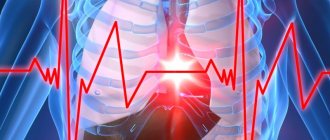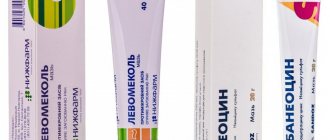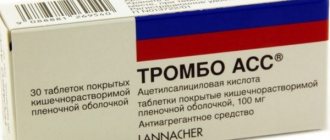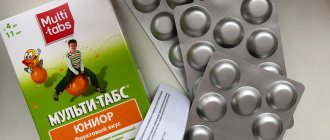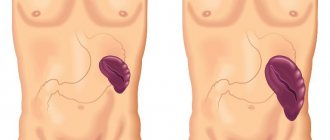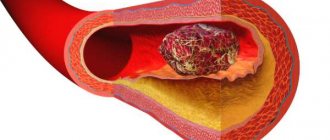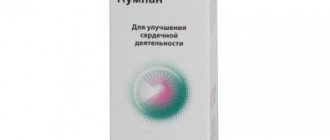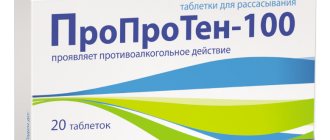Release form and composition
The dosage form of Trombo ACC is an enteric film-coated tablet: white, biconvex, round, shiny, with a smooth or slightly rough surface (14 pcs. in blisters, 2 blisters in a cardboard pack; 20 pcs. in blisters, in a cardboard pack pack of 5 blisters).
1 tablet contains:
- active substance: acetylsalicylic acid – 50 or 100 mg;
- auxiliary components (50/100 mg): colloidal silicon dioxide – 1.5/3 mg; lactose monohydrate – 65/60 mg; potato starch – 5/10 mg; microcrystalline cellulose – 28.5/27 mg;
- shell (50/100 mg): talc – 2.53/3.795 mg; triacetin – 0.68/1.02 mg; copolymer of ethyl acrylate and methacrylic acid (1:1) (Eudragit L) – 6.79/10.185 mg.
International name
Acetylsalicylic acid. In Latin - Acidum acetylsalicylicum.
Thrombo ACC is intended for the treatment of patients suffering from lipid metabolism disorders, diabetes mellitus or high blood pressure.
Indications for use
- unstable/stable angina;
- prevention of transient cerebral circulation;
- primary prevention of acute myocardial infarction in the presence of risk factors (for example, smoking, hyperlipidemia, diabetes mellitus, obesity, hypertension, old age);
- secondary prevention of recurrent myocardial infarction;
- prevention of deep vein thrombosis and thromboembolism of the pulmonary artery and its branches, including use in patients with prolonged immobilization due to extensive surgical interventions;
- prevention of stroke, including use in patients with transient cerebrovascular accidents;
- prevention of thromboembolism after operations and invasive interventions on blood vessels, including endarterectomy of the carotid arteries, coronary artery bypass surgery, coronary artery stenting, angioplasty.
Overdose
If the drug is abused, a clinical picture of an overdose may develop, identical to the symptoms of severe intoxication:
- headache and dizziness;
- tinnitus;
- confusion and loss of consciousness;
- increased sweating;
- increased breathing due to hyperventilation, pulmonary edema;
- arrhythmia, hypotension, cardiac arrest;
- violation of water-salt metabolism;
- gastrointestinal bleeding;;
- drowsiness, coma;
- coma, muscle cramps.
In case of overdose, urgent hospitalization with gastric lavage and administration of adsorbent is required. Treatment is aimed at preserving vital functions and maintaining acid-base, water and electrolyte balance. When the condition normalizes, symptomatic therapy is carried out.
In case of overdose, urgent hospitalization with gastric lavage is required.
Contraindications
Absolute:
- gastrointestinal bleeding;
- hemorrhagic diathesis;
- bronchial asthma associated with therapy with salicylates and other NSAIDs (non-steroidal anti-inflammatory drugs);
- exacerbation of erosive and ulcerative lesions of the gastrointestinal tract;
- severe liver failure (on the Child-Pugh scale - class B and higher);
- severe renal failure (with creatinine clearance <30 ml/min);
- chronic heart failure (according to the NYHA classification – functional class III–IV);
- a combination of bronchial asthma, recurrent polyposis of the nose and paranasal sinuses and intolerance to ASA (acetylsalicylic acid);
- lactose intolerance, glucose-galactose malabsorption, lactase deficiency;
- combination therapy with methotrexate (from 15 mg per week);
- age under 18 years;
- I and III trimesters of pregnancy, breastfeeding period;
- individual intolerance to the components of the drug and other NSAIDs.
Relative (diseases/conditions in which the use of Thrombo ACC requires caution):
- chronic respiratory diseases;
- hyperuricemia;
- gout;
- peptic ulcer of the stomach and duodenum, gastrointestinal bleeding (anamnestic data);
- liver failure (below class B on the Child-Pugh scale);
- renal failure (with creatinine clearance from 30 ml/min);
- hay fever;
- bronchial asthma;
- drug allergies, including to analgesics, NSAID drugs, drugs with antirheumatic and anti-inflammatory effects;
- nasal polyposis;
- proposed surgical interventions, including minor ones;
- combined use with the following drugs: methotrexate (up to 15 mg per week), anticoagulants, digoxin, antiplatelet/thrombolytic agents, NSAIDs and salicylic acid derivatives (large doses), oral hypoglycemic agents (sulfonylureas), insulin, alcohol (including alcoholic beverages ), valproic acid, ibuprofen, selective serotonin reuptake inhibitors;
- II trimester of pregnancy (use of Thrombo ACC is possible only after assessing the balance of benefit and risk, preferably a short course at a dose of up to 150 mg per day).
ThromboASS: instructions for use, price, reviews, analogues, tablets 50 mg and 100 mg
ThromboASS, instructions for use, price, reviews, drug analogues, tablets 50 mg and 100 mg. What does ThromboASS help with, how does it work and what is its effectiveness. Full instructions for use, composition, reviews from doctors and users.
- 1 What is Thrombo ACC, what does it help with?
- 2 Why is the drug prescribed and what does it help with?
- 3 Indications of the drug
- 4 ThromboASS: instructions for use
- 5 How to take in the morning or evening for prevention
- 6 Composition
- 6.1 At what pressure should the tablets be used?
- 7 Price for ThromboASS 100 mg, 50 mg in Russia, Kazakhstan, Ukraine
- 8 Analogues of tablets: ointment, gel, what to replace
- 9 ThromboASS or Cardiomagnyl: which is better, what is the difference, reviews
- 10 ThromboASS or aspirin cardio: which is better, what is different
- 11 Acecardol or ThromboASS: which is better
- 12 Curantil or ThromboASS: which is better, the opinion of cardiologists
- 13 ThromboASS during pregnancy: side effects
- 14 How to deal with blood clots ()
- 15 ThromboASS and alcohol: compatibility, side effects, consequences
- 16 Dosage for adults
- 17 Contraindications
- 18 Photo picture
- 19
- 20 Forum
- 21 ThromboASS: reviews from doctors and patients with varicose veins
What is Thrombo ACC, what does it help with?
ThromboASS (international nonproprietary name acetylsalicylic acid) is a fairly well-known drug all over the world, the country of origin of which is Austria. Release form: tablets in a special coating. The drug group is called non-steroidal anti-inflammatory drugs.
The medicine has a Latin name: Thrombo ASS. The international name is written only in Latin.
You can find out more about ThromboASS on the Radar page and on the Wikipedia website. The drug is aimed at thinning the blood.
The medicine is quite effective for the prevention of diseases such as stroke, heart attack, thrombosis.
What is the drug prescribed for and what does it help with?
ThromboASS is a product based on acetylsalicylic acid. The medicine affects the platelet count, reducing it. Many people are interested in how it differs from aspirin and when it is prescribed. The product helps make the blood less thick. So what is it for and who needs to drink it?
How to take Thrombo ACC in tablet form correctly when treating diseases of the cardiovascular system? The fundamental substance of Thrombo ACC is acetylsalicylic acid, which is effective as an anti-inflammatory agent.
In addition, it reduces blood clotting, and therefore is widely used to treat heart and vascular diseases.
Thrombo ACC in tablets: indications for use
Indications for the use of Thrombo ACC are arthritis, toothache, headache, and neuralgia. Also, the drug in tablets can be used as a means of preventing the occurrence of thromboembolism, the likelihood of which increases after vascular surgery.
Thrombo ACC tablets are intended to be taken over a long period of time. The duration of the course of treatment is determined by the attending physician and can last from two weeks to two months.
Thrombo ACC can be produced in two dosages: 50 and 100 mg. How to take Thrombo ACC and what dosage is optimal will be determined by your doctor depending on the type and degree of pathology, the patient’s weight and his condition. It is recommended to take one tablet of the drug once a day.
Side effects
The drug Thrombo ACC is generally well tolerated by patients, which is due to the low dosage.
In rare cases, the following disorders develop:
- digestive system: abdominal pain, nausea, vomiting, heartburn; rarely - gastric and duodenal ulcers, including perforated, gastrointestinal bleeding, transient disorders of liver function with increased activity of hepatic transaminases;
- hematopoietic system: increased frequency of perioperative (intra- and postoperative) bleeding, nosebleeds, bleeding gums, hematomas, bleeding from the genitourinary tract; in some cases - serious cases of bleeding, including cerebral hemorrhages and gastrointestinal bleeding, which are life-threatening. Bleeding can lead to the appearance of posthemorrhagic/iron deficiency anemia in an acute or chronic course, occurring with corresponding symptoms (pallor, asthenia, hypoperfusion);
- nervous system: dizziness, tinnitus, decreased hearing (may indicate an overdose);
- allergic reactions: cardiorespiratory distress syndrome, Quincke's edema, skin rash, urticaria, itching, rhinitis, bronchospasm, swelling of the nasal mucosa, rhinitis, severe reactions, including anaphylactic shock.
How does a blood thinner work?
Absorbed into the walls of the small intestine, the active substances of the drug enter the blood and bind to its proteins. ASCs are characterized by their location outside cells. But even when bound to protein, it does not lose its activity.
ASA neutralizes thromboxane, an enzyme secreted by activated platelets that serves as a signal to activate other platelets. Deactivated platelets, until the end of their life cycle, lose their ability to aggregate, which contributes to blood thinning.
special instructions
Thrombo ACC should be used as prescribed by a doctor.
It should be taken into account that ASA can lead to the development of bronchospasm, as well as cause attacks of bronchial asthma and other hypersensitivity reactions. Main risk factors: history of bronchial asthma, hay fever, nasal polyposis, chronic diseases of the respiratory system, hypersensitivity reactions to other drugs (for example, itching, skin reactions, urticaria).
Since the duration of the inhibitory effect of ASA on platelet aggregation is several days, the likelihood of bleeding during surgery or in the postoperative period increases (in some cases, a complete refusal of Thrombo ASA may be required at this time).
Low doses of ASA can lead to gout in predisposed patients (with reduced excretion of uric acid).
Exceeding the dose of Thrombo ACC increases the likelihood of gastrointestinal bleeding, which is especially dangerous for elderly patients.
Given the profile of adverse reactions, including the likelihood of dizziness, caution should be exercised while taking Trombo ACC while driving.
How to take Thrombo ACC - before or after meals?
After visiting the doctor, the patient discovers a new drug name on the prescription list. Next to it, usually, there is a short comment indicating the rate of a single dose of the drug, multiplied by the number of doses during the day. In some cases, this information is quite enough, but not when you need to take ThromboASS.
Of course, you can look in the instructions on how to take Trombo ACC tablets to thin the blood; there will definitely be a section there - “method of use”, indicating when to do it, before or after meals. But not as a reproach to the compilers, such instructions are designed for the average non-existent citizen. Next, there is a list of contraindications, where almost everyone finds at least one of their “sores”.
After this, complaints begin about the inattention, and even negligence, of the attending physician. “Stomach patients” are especially indignant and independently switch to analogues that do not contain acids.
So who is wrong? Doctor? Or the specialist who drew up the document accompanying the drug? The answer can be found by referring to the instructions, in the section where the composition of one tablet is described in detail.
Drug interactions
The combined use of Thrombo ACC with the following drugs leads to an increase in their effect (their dose may need to be reduced):
- anticoagulants, thrombolytic/antiplatelet drugs, including clopidogrel, ticlopidine: the likelihood of bleeding increases, which is associated with the synergism of the main therapeutic effects of these drugs;
- methotrexate: associated with a decrease in its renal clearance and its displacement from protein binding;
- selective serotonin reuptake inhibitors: the likelihood of bleeding from the upper gastrointestinal tract increases, which is associated with synergy with ASA;
- drugs with anticoagulant, antiplatelet or thrombolytic effects: the damaging effect on the mucous membrane of the gastrointestinal tract increases;
- oral hypoglycemic agents (sulfonylurea derivatives), insulin: associated with the hypoglycemic properties of ASA;
- digoxin: associated with a decrease in its renal excretion, which may lead to an overdose;
- NSAIDs and salicylic acid derivatives in high doses: the likelihood of an ulcerogenic effect and bleeding from the gastrointestinal tract increases, which is associated with a synergistic effect;
- valproic acid: its toxicity increases, which is associated with its displacement from connection with blood plasma proteins;
- ethanol: the likelihood of damage to the mucous membrane of the gastrointestinal tract and prolongation of bleeding time increases, which is associated with mutually reinforcing effects;
- ibuprofen: the cardioprotective effect of ASA is reduced, which is associated with antagonism against irreversible platelet inhibition.
The combined use of Thrombo ACC with the following drugs leads to a weakening of their effect (dosage adjustment may be required):
- any diuretics: glomerular filtration rate decreases;
- drugs with uricosuric action, including probenecid, benzbromarone: the uricosuric effect decreases;
- angiotensin-converting enzyme inhibitors: the glomerular filtration rate decreases (dose-dependently);
- systemic glucocorticosteroids (except for hydrocortisone, which is used for Addison's disease for replacement therapy): the excretion of salicylates is enhanced and, accordingly, their effect is weakened.
Does the thinning effect of tablets depend on the quantity, quality and time of food intake?
Research conducted on this issue has shown:
- The main part of ASA is absorbed in the small intestine, or more precisely, in its upper part.
- Absorption time does not depend on the degree of fullness of the stomach.
- Antacids that reduce the acidity of gastric juice do not affect the rate at which the body absorbs the drug. The same can be said about milk and other products containing animal fats.
Let's turn again to the instructions, which say that Thrombo ACC tablets should be taken before meals, but not on an empty stomach. We figured out that food does not interfere with the activity of the drug.
It remains to figure out what “not on an empty stomach” means?
You should not take pills immediately after sleep. The stomach also needs time to become active. If, for some reason, the first half of the day is the best option for taking the medicine, then you should eat something first. Even if it is the most insignificant piece of food, it will serve as a command to the stomach to “go.”
ThromboASS for blood thinning, taken on a “lean stomach”, without subsequent food intake, risks dissolving in the stomach. With increased acidity of the environment, the main part of ASA will remain in an acidic solution, increasing the irritating effect on epithelial cells. With reduced acidity of the stomach, ASA is absorbed into the walls of the digestive organ and accumulates in the cells of the mucous membrane, which is not at all desirable.
As you can understand, all these precautions are associated, for the most part, with protecting the digestive system from the negative effects of ASA, and do not in any way affect the thinning effect of the drug.
Pharmacological effect
The treatment process is as follows:
- By stopping the action of active enzymes (cyclooxygenase), the interaction of blood clot-forming components (thromboxane, prostaglandins and prostacyclins), which provoke the development of inflammation, is blocked.
- As a result, platelet activity is lost, the formation of a new enzyme is suppressed, their adhesion and the formation of blood clots - thrombi.
- Aspirin in the composition has a blood-thinning effect, prevents blood thickening and the adhesion of blood clots to the walls of blood vessels.
In addition to the above properties, ThromboASS relieves pain, has an anti-inflammatory effect, and helps reduce body temperature.
Some subtleties
Before purchasing a medication, you should familiarize yourself with the features of its use, as well as the possible risks that may arise when combining ThromboASS with other medications.
- ThromboASS is not recommended for use later than a week before surgery. This is due to the fact that its blood-thinning effect persists for about 4-5 days.
- When taking Methotrexate in combination with ThromboASS, the risk of severe side effects increases sharply. An increased concentration of aspirin in the blood is often accompanied by a hypoglycemic effect, which should be taken into account in patients fighting diabetes mellitus with insulin-containing drugs.
- The medication Ibuprofen and ThromboASS on an aspirin basis are incompatible substances, since as a result of such a combination the cardioprotective effect of the latter is stopped.
Pharmacokinetics
Suction
After taking the drug orally, acetylsalicylic acid is absorbed from the upper part of the small intestine. Cmax in plasma is observed on average 3 hours after taking the drug.
Metabolism
Acetylsalicylic acid undergoes partial metabolism in the liver with the formation of less active metabolites.
Removal
It is excreted by the kidneys both unchanged and in the form of metabolites. T1/2 for ASA is about 15 minutes, for metabolites - about 3 hours.
